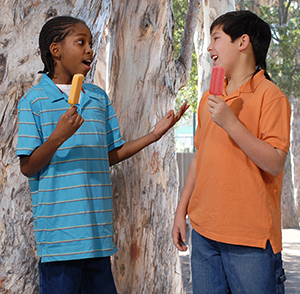When Your Child Has Lactose Intolerance
Lactose intolerance is not a milk allergy. Having lactose intolerance means that your child can’t digest lactose. This is a sugar found in milk and other dairy products. To digest lactose, the body needs a kind of protein (enzyme) called lactase. Lactase is made by cells in the small intestine. Your child’s body may not make enough lactase to digest lactose. Undigested lactose can cause uncomfortable symptoms. Lactose intolerance can be managed so your child can feel better.
 |
| Your child can still enjoy non-dairy treats like juice bars. |
What are the symptoms of lactose intolerance?
Lactose intolerant children can have painful symptoms after eating or drinking dairy products. Common symptoms include:
-
Bloating
-
Extra gas
-
Upset stomach (nausea)
-
Vomiting
-
Diarrhea
-
Belly pain or cramping
Symptoms happen 30 minutes to 2 hours after having milk or milk products. Symptoms range from mild to severe. This depends on how much lactose your child ate or drank and the amount they can handle.
How is lactose intolerance diagnosed?
The most common test used to diagnose lactose intolerance is called the hydrogen breath test. This test measures the level of a gas called hydrogen in your child’s breath. Hydrogen is made by bacteria in the large intestine (colon) in response to undigested lactose. Hydrogen is carried through the bloodstream to the lungs, where it's breathed out. High levels of hydrogen in your child’s breath means that lactose isn't being digested correctly. Other tests include stool tests which measure the amount of undigested sugar or acidity in the stool as a marker of undigested lactose. Sometimes your child will need an endoscopy. During this procedure, samples may be taken of the small intestine. The absence of lactase shows a lactose intolerance.
How is lactose intolerance treated?
One way to manage your child’s symptoms is to reduce or eliminate sources of lactose. This includes most dairy products, such as:
-
Milk
-
Butter
-
Cream
-
Cheese
-
Ice cream
Children with lactose intolerance can sometimes eat or drink dairy products without symptoms. At first your child’s healthcare provider may want to remove all lactose from your child’s diet to stop symptoms. Then you can work with the provider to learn what kinds of dairy products your child can handle. Your child's provider may advise a lactase enzyme supplement to help your child digest lactose without having symptoms.
Kids need calcium and vitamin D
Dairy products are a good source of calcium and vitamin D. Kids need calcium and vitamin D for bone growth and strength. Talk with your child’s healthcare provider about ways to give your child enough calcium and vitamin D. Foods that contain calcium include:
-
Green vegetables such as broccoli, kale, bok choy (Chinese cabbage), and turnip greens
-
Fish with edible bones, such as canned salmon
-
Alfalfa or soy sprouts
-
Tofu, soybeans, pinto beans, and navy beans
-
Almonds
-
Sesame seeds
-
Molasses
-
Calcium-fortified drinks, such as orange juice, soymilk, and rice milk
-
Lactose-free milk and other lactose-free dairy products
Online Medical Reviewer:
Jen Lehrer MD
Online Medical Reviewer:
Raymond Kent Turley BSN MSN RN
Online Medical Reviewer:
Rita Sather RN
Date Last Reviewed:
12/1/2021
© 2000-2024 The StayWell Company, LLC. All rights reserved. This information is not intended as a substitute for professional medical care. Always follow your healthcare professional's instructions.